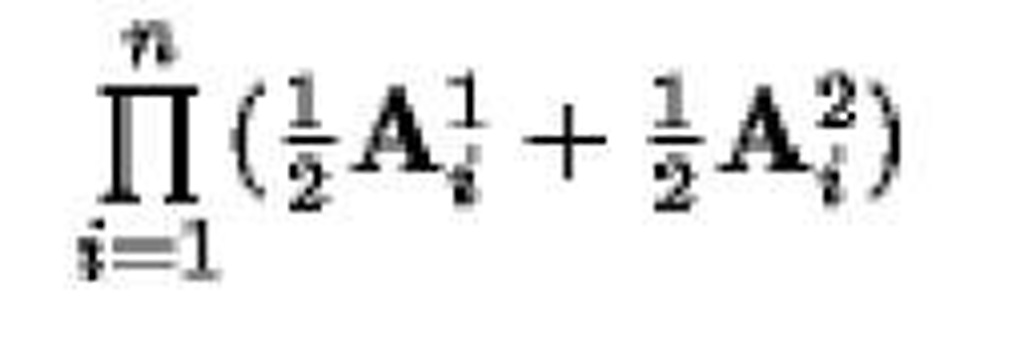Mendelian inheritance patterns occur when (i) alleles in heterozygous diploids have equal chances of being transmitted to haploid gametes, thus giving rise to a 1:1 segregation, (ii) alleles of different loci combine at random in the gametes, and (iii) gametes fuse at random to form diploids.
The name Mendelian honors Gregor Mendel, who observed and counted carefully the phenotypes produced in many crosses of pea plants, Pisum sativum (1). This plant was convenient because of its relatively short generation time, easy handling, and abundant offspring. He tried other plants as well; and he found confirmatory evidence with some of them, and results that could not be understood at the time with others—for example, Hieracium.
Mendelian inheritance is sometimes expressed in the form of Mendel’s laws, although we owe this formulation largely to later writers, such as C. Correns and H. de Vries. The first law is the law of segregation (of alleles to gametes); the second is the law of independent assortment (of alleles of different genes). The uniformity of the hybrid generation is sometimes considered a law as well.
Two underlying assumptions of Mendelian inheritance were introduced before Mendel. One is the individuality and autonomy of inherited traits: Many traits present clear alternatives that are preserved in successive generations without blending (see Genetic Marker). The other is the combination of separate traits with each other. These assumptions were expressed clearly by Michel Sageret (2) following his observations with melons, Cucumis (Cucurbita) melo. He found "marked combinations of various characters without any mixture between them" and understood that this gives, nature "the ability to vary infinitely its products and avoid monotony." The combinations of individual traits superseded the traditional holistic opinion for which every aspect of living beings had to be seen as a manifestation of a whole.
It is not generally known that Sageret came close to summarizing Molecular Biology, using in the figured sense terms from the arts of typography and casting, as our textbooks do today: "To what is due this ability of nature to reproduce in the descendants characters that belonged to their ascendants? We do not know, but we may well suppose that it depends on a type, on a primitive mold that contains the germ of all the organs, germ that sleeps and awakes, and develops or not according to the circumstances".
The rules of Mendelian inheritance provide quantitative forecasts for the frequency of different traits and their combinations in the offspring of defined genetic crosses. Consider a pair of genetic markers, phenotypes "A" and "a," governed by the alleles A and a of a single gene (see Genetic Marker), and two diploid parents that "breed true" [ie, are homozygous for the alleles under consideration (see Homozygote, True Breeding)]; the parental genotypes are written AA and aa to indicate the fact that diploids carry two copies of each allele (Table 1). Their gametes carry alleles A and a, respectively, and the F1 diploids produced by their fusion will be Aa. The phenotype of the offspring will be uniform and will depend on the dominance or recessivity of the alleles; assuming that A is dominant over a, the offspring phenotype will be "A." The gametes of F1 individuals will have equal chances of carrying the A or the a allele; this is conveniently represented by an algebraic sum in which each allele takes its probability as a coefficient. The fusion of gametes of F1 individuals produce a heterogeneous F2 segregation: The random combination of gametes is well represented by the multiplication of their respective algebraic expressions (the squaring, in this case) and yields an algebraic expression of all genotypes each with its own probability as coefficient. The offspring of other crosses—for example, a backcross—is easily predicted by similar considerations.
Table 1. Mendelian Segregation of a Monohybrid (a Dominant Allele A and a Recessive Allele
This algebraic treatment can be generalized to several genes, each with their respective alleles (Table 2). Again, multiplication of polynomials expresses the random combinations of the alleles of different genes.
Table 2. Mendelian Segregation of a Multihybrid (n Pairs of Alleles, Aj and A j)
|
Generation P1: |
 |
 |
 |
|
Their gametes: |
 |
 |
 |
|
Generation F1: |
 |
 |
 |
|
Their gametes: |
 |
 |
 |
|
Generation F2: |
 |
 |
 |
Mendelian inheritance is a consequence of the phenotypic traits being governed by individual genes located on the chromosomes. It is valid for genes located in the autosomes (chromosomes present in two copies in a diploid nucleus) and must be modified in the cases of imperfect diploidy, such as sex linkage and aneuploidy. The random combinations of different traits apply only when the responsible genes are located on different chromosomes or at sufficient distance in the same chromosome. Genes located sufficiently close to each other in the same chromosome tend to be transmitted to the gametes as a block.
The random segregation of alleles to the gametes does not occur in the presence of segregation distorters. Thus, gametes with certain changes in the structure or the number of chromosomes are formed less often than expected, particularly in the meiosis of females. Some genetic elements actively bias the segregation to their own favor. This phenomenon is called meiotic drive. Some meiotic-drive elements fail to impose themselves on the whole population because they are held in check by opposing selection pressures.
Independent assortment of chromosomes does not occur when there is affinity between some nonhomologous chromosomes, so that they tend to move together during meiosis. The result is an apparent linkage between alleles of different chromosomes. is approximately unity. The equilibrium constant for the reduction of stable disulfide bonds in folded proteins.







